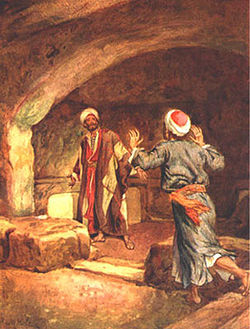
John 20:6
Encyclopedia

Gospel of John
The Gospel According to John , commonly referred to as the Gospel of John or simply John, and often referred to in New Testament scholarship as the Fourth Gospel, is an account of the public ministry of Jesus...
in the Bible
Bible
The Bible refers to any one of the collections of the primary religious texts of Judaism and Christianity. There is no common version of the Bible, as the individual books , their contents and their order vary among denominations...
. Peter
Saint Peter
Saint Peter or Simon Peter was an early Christian leader, who is featured prominently in the New Testament Gospels and the Acts of the Apostles. The son of John or of Jonah and from the village of Bethsaida in the province of Galilee, his brother Andrew was also an apostle...
and the Beloved Disciple have just arrived at the empty tomb of Jesus
Jesus
Jesus of Nazareth , commonly referred to as Jesus Christ or simply as Jesus or Christ, is the central figure of Christianity...
. The Beloved Disciple, who arrived slightly ahead of Peter, paused outside the empty tomb
Empty tomb
Empty tomb most often refers to the tomb of Jesus which was found to be empty by the women who were present at Jesus’ crucifixion. They had come to his tomb to anoint his body with spices...
. In the verse, Peter enters the tomb upon his arrival.
In the King James Version of the Bible, the text reads:
- Then cometh Simon Peter following
- him, and went into the sepulchre,
- and seeth the linen clothes lie,
The World English Bible
World English Bible
The World English Bible is a public domain translation of the Bible that is currently in draft form. Work on the World English Bible began in 1997 and was known as the American Standard Version 1997...
translates the passage as:
- Then Simon Peter came, following
- him, and entered into the tomb.
- He saw the linen cloths lying,
Though Peter arrived second, he enters the tomb first. To F.F. Bruce, Peter entering the tomb as soon as he arrives shows his "characteristic impetuosity". That Peter enters the tomb without trepidation or hesitation is seen by other scholars as an indication that he was not greatly affected by guilt due to the events surrounding the crucifixion
Crucifixion
Crucifixion is an ancient method of painful execution in which the condemned person is tied or nailed to a large wooden cross and left to hang until dead...
. Barrett states that the passage is an attempt to subordinate the Beloved Disciple to Peter and make up for the disciple beating Peter in the race for the tomb.
The word translated as seeth/saw is closer to examine, implying that that Peter is paying detailed attention to the strips of linen. This contrasts with the previous verse, where the Greek implies the Beloved Disciple gave a much shorter glance to the linens.
The strips of linen presumably refer to the grave clothes of Jesus that are discussed in greater detail in John 20:7
John 20:7
John 20:7 is the seventh verse of the twentieth chapter of the Gospel of John in the Bible. In this verse, Peter is standing in Jesus's empty tomb. The Beloved Disciple and perhaps Mary Magdalene are outside...
. Some translators believe "lying there" is best interpreted as "lying on the ground". Brown
Raymond E. Brown
The Reverend Raymond Edward Brown, S.S. , was an American Roman Catholic priest, a member of the Sulpician Fathers and a major Biblical scholar of his era...
disagrees and reads this turn of phrase as evidence that the grave clothes were sitting upon a shelf in the tomb. It is notable that John refers to the grave clothes as "strips". In Luke and traditionally, Jesus was wrapped in a shroud
Shroud
Shroud usually refers to an item, such as a cloth, that covers or protects some other object. The term is most often used in reference to burial sheets, winding-cloths or winding-sheets, such as the famous Shroud of Turin or Tachrichim that Jews are dressed in for burial...
.

